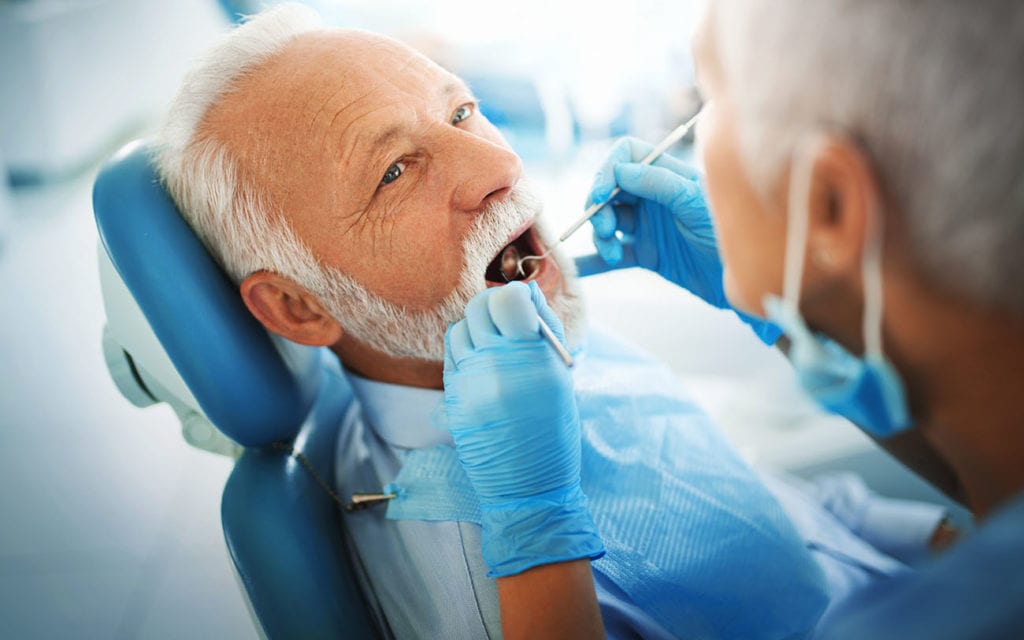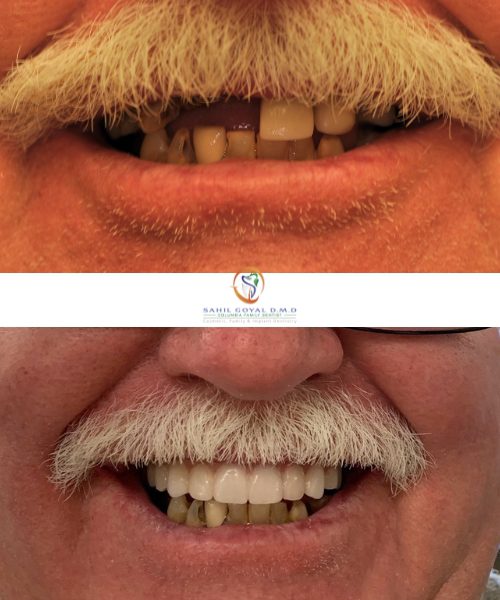A dental bridge is a restorative dental solution that replaces one or more lost teeth. We can provide you with fixed or removable dental bridges. Fixed bridges permanently attach to your mouth using dental implants.
Dr. Sahil Goyal offers several types of dental bridges to accommodate patients and their different needs. After an exam, he will determine which one is right for you to give you a healthier and more functional mouth. He will design a natural-looking dental bridge that will blend in seamlessly with the rest of your teeth.

What is a Dental Bridge?
A dental bridge is a custom-made single fixture that the dentist installs along the arch to replace one or more teeth. On each end of the bridge is a dental crown with the false teeth (the pontics) in between them. The crowns attach to anchor teeth, or abutment teeth, to hold the prosthetic firmly in place. We have several types of dental bridges available, including the following:
- Removable Dental Bridge: Consisting of pontics that attach to a framework with metal clasps. The clasps rest on your remaining teeth to hold the prosthesis in place. We recommend this option for short-term or temporary use, because it is not that sturdy.
- Traditional Dental Bridge: Consisting of two dental crowns on each end, with the pontic(s) in the middle. The dentist will remove some enamel from the two teeth adjacent to the gap to prepare them for the dental crowns. This is a type of fixed bridge since the dentist will cement the crowns to the adjacent teeth.
- Cantilever Bridge: This is exactly like a traditional fixed bridge, however it will only use one abutment tooth. The bridge will only have a dental crown on one end. Dentists only use this option when only one adjacent tooth is available.
- Maryland Bridge: This is a unique bridge because the pontic appears to have metal “wings” attached to it. The dentist bonds the metal framework to the back side of two adjacent teeth.
- Implant Supported Bridge: Patients missing two or more teeth can benefits from dental implants. This solution involves using implants to secure the bridge instead of healthy, remaining teeth. To learn more about how dental implants work, visit Dental Implants.
Patient Review
What to Expect During the Bridge Process
The dental bridge procedure usually takes two or three appointments to complete. Typically, during a routine check up your dentist will discover damage to a tooth that may require a dental bridge. If you have a missing tooth, Dr. Goyal may suggest a dental bridge. He will discuss all your treatment options and take x-rays to prepare for the procedure.
At the next appointment, Dr. Goyal will prepare the abutment teeth on either side of the gap. This step involves removing a portion of the enamel and reducing the size of the teeth. This ensures that the teeth are smooth for the restoration. It also ensures there is space for the bridge to fit comfortably.
After Dr. Goyal prepares the teeth, he will take dental impressions. We will use the impressions to create molds and then send them to a lab where they will construct the dental bridge. We will also make a temporary dental prosthetic to protect your teeth until the bridge is ready. The prosthetic will help you eat, speak, and smile normally while waiting for the final bridge.
At your last appointment, Dr. Goyal will try the bridge on your mouth to ensure a proper fit. He will make any adjustments if necessary. Then he will cement the dental bridge in place with dental adhesive.
Implant-Supported Dental Bridges
Implant-supported dental bridges offer an excellent solution for replacing missing teeth. Unlike traditional bridges or dentures, this option combines the stability of dental implants with the efficiency of a bridge. Patients who choose implant-supported bridges enjoy several advantages that improve both oral health and quality of life.
Improved Stability and Function
One of the biggest benefits of implant-supported bridges is their stability. Dental implants act like artificial tooth roots, anchoring the bridge securely to your jawbone. This stability ensures that the bridge does not shift or move while you eat, speak, or smile. You can enjoy your favorite foods without worry, including hard or sticky items that might be challenging with traditional dentures. The firm support of implants makes this option feel more like your natural teeth.
Prevents Bone Loss
When you lose a tooth, the jawbone in that area starts to shrink because it no longer receives stimulation from chewing. Over time, this bone loss can weaken your jaw and change the shape of your face. Implant-supported bridges solve this problem by stimulating the jawbone, just like natural tooth roots. This helps maintain bone density and keeps your jaw strong and healthy.

Long-Lasting Solution
Implant-supported dental bridges are a durable and long-lasting option. Dental implants can last a lifetime with proper care, and the bridge can remain in good condition for many years. This makes them a cost-effective solution over time, as you won’t need frequent replacements as you might with traditional bridges or dentures.
Protects Healthy Teeth
Traditional dental bridges rely on the surrounding teeth for support. To place a bridge, a dentist often has to grind down healthy teeth to attach crowns that hold the bridge in place. Implant-supported bridges eliminate this need. Because the implants serve as the foundation, the surrounding natural teeth remain untouched and intact. This preserves the health and strength of your existing teeth.
Natural Appearance
Implant-supported bridges look and feel like natural teeth. They are custom-designed to match the shape, size, and color of your remaining teeth, creating a seamless and attractive smile. The implants hold the bridge securely in place, so there are no visible metal clasps or awkward gaps.
Easy Maintenance
Caring for an implant-supported bridge is simple. You can brush and floss around the implants and bridge like your natural teeth. Regular dental check-ups and cleanings help ensure your implants and surrounding gums stay healthy. Unlike removable dentures, you don’t need to worry about adhesives or leaving the bridge at night.
Enhanced Confidence
Living with missing teeth can impact your confidence and make you hesitant to smile or speak. An implant-supported bridge restores your smile and helps you feel more confident in social and professional situations. Knowing your dental bridge is secure, you can talk clearly, chew comfortably, and smile freely.
Post Dental Bridge Procedure
You may feel numbness in your tongue, lips, and roof of your mouth while the anesthetic wears off. Please refrain from eating and drinking hot beverages until the numbness subsides.
For the first few days, avoid eating sticky and hard foods, and chew on the opposite side of your mouth. Brush normally, but floss carefully. Do not pull the floss upward, because this can dislodge a temporary bridge.
Experiencing some temperature and pressure sensitivity after each appointment is normal. The sensitivity should fade a few weeks after we place your bridge. You may use mild pain medications, but they are not always necessary. If your bite feels uneven, have persistent pain, or have questions or concerns, please contact our Frederick dental office.
Dental Bridge FAQs
Please take some time to review our frequently asked questions about dental bridges. If you still need further information, do not hesitate to call our office.
Can dental bridges damage teeth?
Your teeth always has the potential to incur damage. Dental bridges can potentially cause damage to the surrounding teeth. The process of preparing the adjacent teeth to support the bridge involves removing tooth enamel. This will weaken the tooth structure of those teeth.
Also, the pressure from the bridge sitting on the supporting teeth can potentially cause damage over time. Minimize the risk of any potential damage with proper oral hygiene and regular dental check-ups.
Why do dental bridges fail?
A dental bridge is a great way to replace teeth however there is always a chance of failure. In most cases, poor oral hygiene is by far the most common and preventable cause. If you do not brush and floss regularly, bacteria can get under the crowns of your bridge.
This can lead to decay and gum disease and weaken the support teeth for the bridge. However, trauma to the mouth, an improper fit, and everyday wear and tear can also cause the dental bridge to fail.
What happens if you get a cavity under a bridge?
If your dentist discovers a tooth cavity on a tooth that is supporting your dental bridge, he will need to treat it. If caught early enough, your dentist will apply a simple tooth filling to fix it. However, the dentist will have to remove the bridge, treat the tooth, and create a new bridge if the cavity is large.
Extreme decay may require an extraction. In this case, you may want to consider getting dental implants to replace your missing teeth instead of a bridge.
Can food get stuck under a bridge?
Food can easily become stuck beneath or around a bridge since there is a small gap underneath the prosthetic tooth. Routine exams are crucial to ensure that your dental bridge fits and functions properly. Carrying floss threaders and/or dental brushes with you will assist you remove food particles if they become trapped between your teeth. Failing to remove food particles and debris regularly will result in decay and gum disease.
Can you sleep with a removable bridge in?
You should remove your dental bridge each night and store it while you sleep. This gives the mouth muscles, gums, and surrounding teeth a resting period. These kinds of oral devices can also harbor bacteria and hinder the mouth’s natural ability to clean itself. So practice good oral care, and clean your bridge every time you remove it at night.
Is the process to get a bridge painful?
The process for placing the dental bridge in your mouth is rather simple and painless. To keep you pain-free throughout the procedure, we will numb the area before beginning treatment. This will ensure that you are pain free and comfortable during the procedure. You may feel pressure while we prepare the teeth, however.
Replace multiple missing teeth with a dental bridge by calling Dr. Goyal’s dental office at 301-264-5680. You may also schedule an appointment online.
